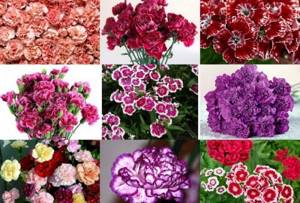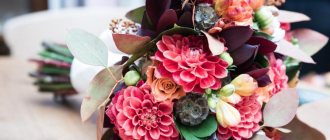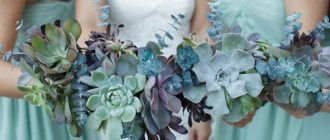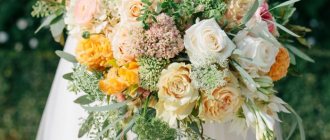What is the difference between a designer bouquet and a regular bouquet from a catalog?
Unlike designer bouquets, bouquets from the window are simple, they use ordinary varieties of flowers, inexpensive packaging and they have a familiar shape - round or, at best, oval. After all, the bouquets from the catalog are designed primarily so that they can be bought in any situation. Such a bouquet can be interesting, impressive, and it can be assembled with high quality by an experienced craftsman... But still, such a bouquet should not stand out too much - otherwise it may not have time to sell.
But designer bouquets are always expressive, they use unusual varieties of flowers, spectacular design and are assembled by experienced craftsmen. Of course, an author's bouquet cannot stand on a display window and is always made to order, but unlike custom-made compositions, in author's bouquets the choice of idea always remains with the master. It is he who determines the concept of the bouquet, color combinations, shape and packaging.
Flowers in a designer bouquet.
Nowadays you can find many exotic flowers in Moscow. In 2019, peonies, lilies of the valley and hydrangeas will be especially popular, but experienced craftsmen often use very rare varieties of flowers, such as echeveria or anthurium.
The shape of the author's bouquet.
The shapes of designer bouquets can also be very diverse, asymmetrical, chaotic, enormous in size, or, on the contrary, very small and elegant. The master makes a designer bouquet to order and therefore he can afford to embody all his ideas and ideas in the bouquet.
Design and packaging of an author's bouquet.
When decorating bouquets, the highest quality materials and trendy ideas are used, such as craft paper, boxes or envelopes. But some masters make bouquets without packaging or additional decoration - flowers as they are. Be sure to discuss all these issues with your florist.
Exotic flowers for bouquets
Modern floristry allows compositions not only from popular flowers that we all know, but also from exotic ones.
The composition of bouquets involves plants whose names are known to few due to their foreign origin.
Amaryllis
Found among indoor plant lovers, it comes from South Africa.
The amaryllis used to create bouquets is an artificially bred hybrid. The flowers come in a variety of shades, from soft cream to deep purple. There are striped varieties.
There are up to 4 large buds on one stem. All of them have a pronounced bell shape and have a pleasant aroma.
Agapanthus
The African lily is native to South Africa. When flowering, it produces a powerful stem up to 1 m high, on which there are flowers of blue, purple or blue shades, shaped like a lily.
It is used in elongated bouquets. Agapanthus inflorescence can contain up to 150 buds, which open gradually, providing up to 60 days of continuous flowering.
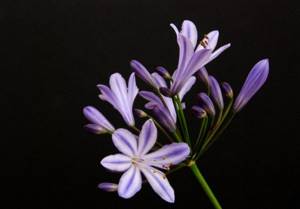
We recommend reading the article about caring for agapanuts at home and in the country.
Alstroemeria
Originally from South America, it was brought to Europe in the 18th century, belongs to exotic plants, and is well known in Russia. Alstroemeria is surrounded by an area of magical rumors and legends; in its homeland it was revered and cultivated by the Indians.
The beauty is that when cut, it remains fresh for up to 3 weeks and has a neutral aroma. Every day new buds bloom, refreshing the composition. The flower is widely used as an addition to bouquets due to its rich color palette. The flowering period lasts almost the entire summer.
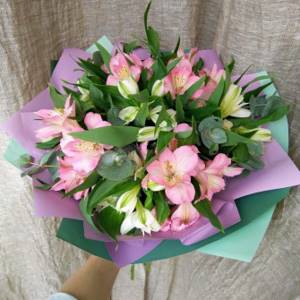
Anemone
The light and delicate bowl of the flower sways at the slightest breath of wind, which is most likely why it received the name anemone, translated from Greek as “wind”.
Botanists distinguish two types of plants: chamomile and poppy. They are distinguished by the shape of the petal.
It blooms almost all year round around the globe. Having blossomed, it has a diameter of no more than 4 cm and a height of about 15 cm. Many shades of the plant are known.
In compositions, anemones are used rather as auxiliary ones, but there are also individual bunches, most often imitating a bouquet of “poppies”.
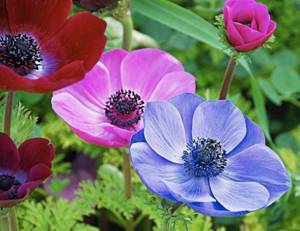
Read more in the article about anemone.
Anthurium
Widely known among indoor plant lovers. Its inflorescence is a red, pink or white cup with a spadix in the center. The flower size reaches 10 cm.
Anthurium is native to the American tropics. There are more than 800 species, but flowers with blankets of bright colors are most often used in compositions.
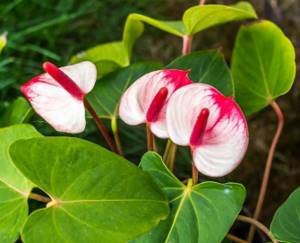
The use of anthurium in bouquets symbolizes good luck in love and increased creative potential. Usually florists put it in a bunch with roses, lilies and orchids.
Hyacinth
It is often confused with snowdrop, most likely due to the fact that in its homeland in Asia Minor it blooms during the first spring rains.
The plant has made a long journey from Asia through Turkey and Austria. Arrived in Holland, from where it spread throughout the globe.
There are already several thousand varieties of hyacinth, and new ones appear every year. Each species has its own flowering period, so the plant can be used all year round.
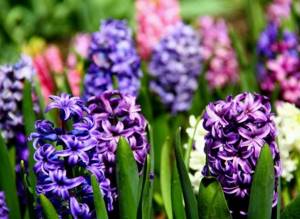
In combinations with roses and orchids, its beauty and tenderness are revealed as effectively as possible. The fresh aroma harmoniously complements the composition, and many different shades open up space for creativity.
Read more about hyacinth here.
Hydrangea
The flower was named after the sister of a prince of the Holy Roman Empire. Later, hydrangea received the second name “water jug”. It is believed that the reason for this was the plant’s great love for watering.
The worldwide expansion of hydrangea began in the 18th century when it was first brought from China. In the 19th century, it appeared in Europe and very quickly spread throughout the globe.
It blooms almost all year round in shades of red, pink, blue, white, light blue and lilac. Such variety of colors and beautiful large inflorescence stimulates the imagination and reveals creative potential. Hydrangea can be seen in combination with roses, gerberas, field herbs and in independent bouquets.
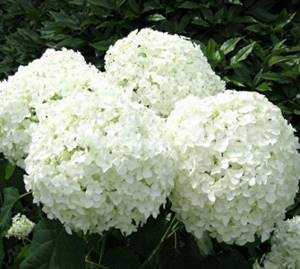
If you want to learn more about hydrangea, check out this article.
Gerbera
“Colored chamomile” is widely known not only to florists, but also to simply amateurs. Rich shades, large flowers and unique durability have made gerbera popular all over the world.
The plant, originally from the South American colonies, took root in Europe quite quickly. In the first year after planting, the bush does not bloom, but then it pleases the owner with a large number of buds on high legs. The size of the flower cup can reach up to 30 cm in diameter, depending on the subspecies. Gerberas are distinguished by a unique number of shades and an unusually beautiful gradient from the center to the edge of the petals.
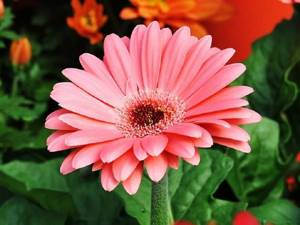
Herminie
Small, colorful daisies come from South Africa and are often confused with gerberas. Distinctive characteristics include the small size of the flower and short stem.
Plants are resilient and can remain fresh for up to 20 days. In wedding compositions they are used without a porta bouquet; they can easily go without water for a long time.
Germinies are combined with roses, field daisies, lilacs, and hydrangea.
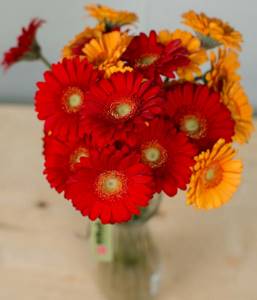
Gypsophila
The plant is found in Asia and Eastern Europe and has more than 100 species.
Gypsophila is a cluster of graceful branched stems with many small flowers. Small bowls of white and pink shades look delicate and airy. Large round or disc-shaped buds complement bouquets well.
Gypsophila is popularly nicknamed “clouds”. It is perfectly preserved when cut and can be dried for use in compositions.
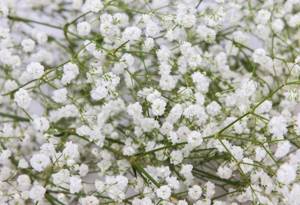
Calla
This unusually beautiful flower has many names, but the most popular is calla. The plant's homeland is South Africa. They are divided into two types: some high with white bowls, others low with a colored blanket.
The bouquets are varied, but regardless of the choice, the colors are a symbol of beauty, admiration, and delight. It is customary to give calla lilies as a wedding gift; according to legend, they eliminate quarrels and misunderstandings in the family.
The blanket reacts sensitively to touch. A pre-wilting stain begins to appear at the point of contact. If contact is excluded, a cut flower can last up to several weeks.
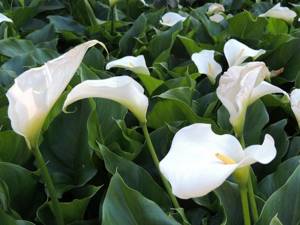
Read more in the article about calla lilies.
Campanula
The plant of the bellflower family, native to the Mediterranean, has about 300 species, but only two have received special names.
The Alba variety is called the bride; its flowers are distinguished by their snow-white purity. The Maya variety, with a beautiful blue hue, is called the groom. The use of plants in wedding bouquets is obvious.
The height of the Campanula stem is small, only 15 cm. The diameter of the flower cup is 3.5 cm. The plant is light-loving and does not tolerate cold.
Used in compositions with roses, peonies, anemones and other large flowers.
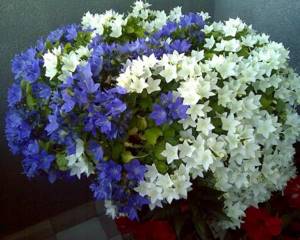
More is written about Campanula or the bride and groom flower here.
Crocus
The delicate plant blooms in early spring and late autumn and is also known as saffron. The flowering period directly depends on weather conditions. The low stem supports an elegant bowl of white or lilac color.
In total there are about 80 species of crocus, but, unfortunately, many of them are already listed in the Red Book. Saffron is most often found in nature in the Mediterranean and Central Europe.
Crocus has been used since ancient times as an incense and seasoning; numerous medicinal properties of the plant are known.
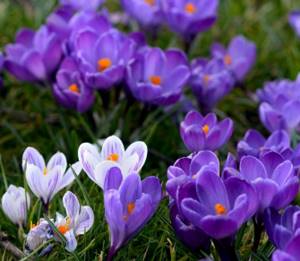
In bouquets they can act as an excellent addition to orchids, roses, and peonies.
Also read about when and how to plant crocuses in the country.
Orchid
Today it is found on all continents except Antarctica, but most species grow in the tropics. This parasitic plant is distinguished by the unprecedented beauty of its flower and its not always pleasant aroma. There are certain species with a downright repulsive odor.
Orchids, depending on the type, come on long or short stems. On high legs, sometimes whole inflorescences are visible, including from 5 to 20 flowers, which open gradually and can remain fresh for a long time.
In a bouquet they are often installed in a special device with a water container.
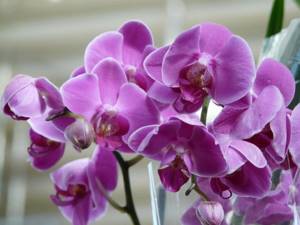
Also read articles about different types of orchids and proper care for them:
- Miltonia.
- Wanda.
- Cymbidium.
- Vanilla.
- Ludisia.
- Masdevallia.
- Oncidium.
- Lady's slipper.
- Zygopetalum.
- Cattleya.
- Brassia.
- Phalaenopsis.
Lily of the valley
Forest flower, grows everywhere. Flowering period is spring. Loves sunny meadows and woodlands. The medicinal properties of the plant are widely known.
In the composition, lily of the valley is associated with sadness. This is due to the white color of the bowl and the red fruit.
The French first began using these flowers in bouquets; later, florists from other countries took up the initiative. Some species are listed in the Red Book.
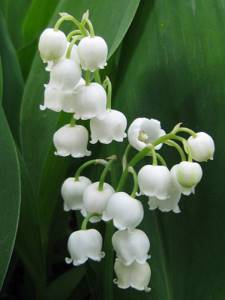
Read more in the article about lilies of the valley.
Lavender
An evergreen shrub with a rich aroma, widely used in perfumery. About 50 varieties of the plant and its hybrids are known today.
Lavender gets its name from the Latin word for “to wash.” It was previously native to the Mediterranean and was used by the Romans to scent baths. Later in medieval Europe, lavender began to be used for medicinal purposes.
Florists value the plant for its ability to decorate and refresh any bouquet, giving it special tenderness and grace. In addition, lavender lasts a long time when cut and does not need watering.
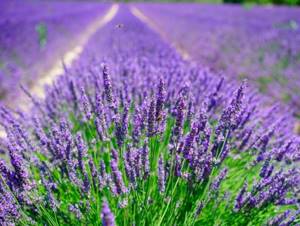
Lily
The plant has more than 110 species. About 18 of them can be found in Russia, but the most popular is the Saranka variety, which is known for its delicate pink flowers and complete absence of odor.
A neutral aroma for lilies is an advantage, as some of them have a heavy, suffocating odor. The plant is afraid of cold weather and needs good shelter.
This flower combines well with other plants, so it is often used in combinations with phlox, daisies, peonies and irises. It is not advisable to combine the plant with poppy and cornflowers.
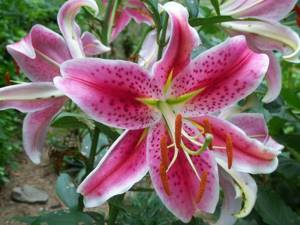
Also read about the varieties of lilies and the rules for planting them.
Lisianthus
Eustoma is native to Central America. The flowering period is summer, but modern technologies make it possible to maintain growth throughout the year.
Despite the large number of species, only Russell's lisianthus is suitable for bouquets. Shades of the bud are soft lilac, pink, white and purple. The bicolor varieties won special praise.
The flower is used to decorate brides' bouquets. With its help, any composition acquires special tenderness and airiness. The plant combines well with all exotics, emphasizing the individuality of the bouquet.
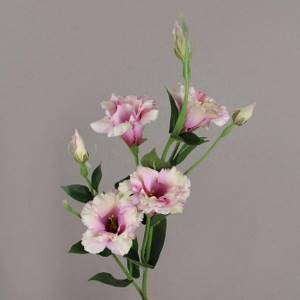
Daisy
It got its name from the Greek word for “beautiful”. Its homeland is Mediterranean and Asian countries.
It first appeared in Europe in the 16th century, where it gained wide popularity. The flower symbolizes purity and innocence.
In the Middle Ages it was used for medicinal purposes. It was believed that daisy tincture cures all diseases; if the patient does not recover within 15 days, then he is destined to die.
There are more than 30 species in nature, but only one is used in bouquets. The perennial daisy comes in red, yellow, white or pink. Combines well with daisies and roses.
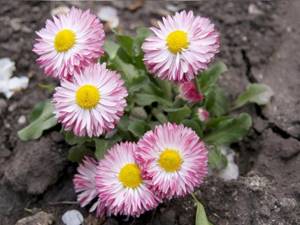
Mattiola
Levkoy is an ornamental plant with a pleasant aroma. Flowers bloom at night, so their scent becomes richer and brighter. It is also called "night violet".
There are 22 species that bloom from early summer to mid-autumn. Mattiola is frost-resistant and does not need frequent watering; most often it is planted in open ground.
Florists use plants in independent compositions and in bundles.
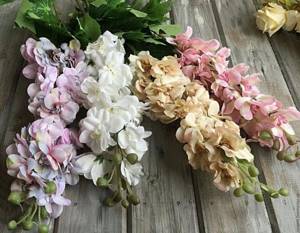
Hellebore
The Christmas rose is not afraid of the cold, despite its beauty and tenderness. The medicinal properties of the plant have been known since ancient times, but, in addition, it is famous for the fact that it can also be poisonous.
In bouquets, white hellebore is a good addition; it creates an accent on the brighter buds, giving the bunch a special quivering tenderness.
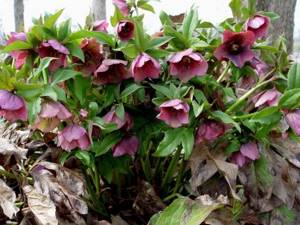
In addition to the snow-white variety of hellebore, there are colored hybrids that are dark purple, plum, red, yellow, green and almost black.
Sunflower
"Sun Flower" arrived from North America. The plant was brought to Europe by the Spaniards, and later Tsar Peter brought it to Russia.
For people, the sunflower flower carries different meanings, for example, in heraldry it is a symbol of peace, sunshine, unity and fertility. Today there are more than 180 species. They differ in stem height, number of inflorescences, cup sizes, and shades.
Florists use the Bear variety, which is the most convenient to work with. It is small and fits well into compositions.
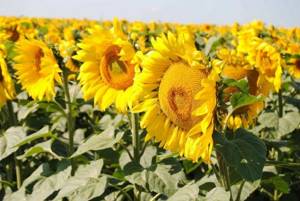
Strelizia
Anyone who has ever seen this herbaceous plant native to South Africa will remember it forever. Its inflorescence is popularly called the “bird of paradise.”
The stem reaches a height of 1.5-2 m, but a trunk is not formed. Strelitzia is a long-growing plant that has to wait several years for its first flowering. It is undemanding in care and stands for a very long time in its blooming state.
Used as a bright accent in the composition.
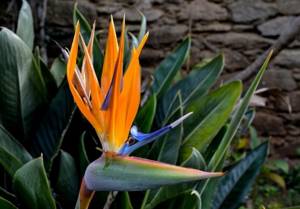
Freesia
The South African plant began to be grown as an ornamental towards the end of the 19th century. The most popular species, hybrid freesia, is most widely used due to its aroma, similar to that of lily of the valley.
The tall stem branches in the upper part, combining from 2 to 5 flowers in each inflorescence.
The coloring is varied; they are used in compositions as an independent plant, as well as in bundles.
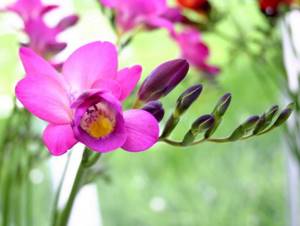
Read more in the article about freesias here.
Author's bouquet or custom-made bouquet?
So, if the bouquet from the window is definitely not your choice, then what should you choose - an author’s bouquet or a custom-made bouquet? If you know exactly what bouquet you need, what shape and what colors, then you need a custom-made bouquet - just tell the master what you need. Our studio employs experienced craftsmen and we will fulfill all your wishes exactly as you want.
And if, in addition to the fact that you know who you will give flowers to, you only have general wishes and an approximate budget, then your choice is a designer bouquet. The master will independently make the bouquet, relying on his experience, knowledge about the person and the upcoming event.
Carnations - divine flowers
Experienced breeders have developed many varieties of carnations to create rock gardens and beautiful flower beds. Modern hybrids of carnations are excellent flowers for creating luxurious bouquets; their photos with names are proof of this:
- Grass is the name given to small flowers in bouquets; they are often used to decorate borders, rock gardens and local areas.
- Lush carnations thin out the delicate pleasant aroma, small rare inflorescences are complemented by other flowers.
- Shabots are velvety flowers of exquisite beauty. They retain their shape and attractiveness in finished compositions for a long time.
- Turkish or bearded carnations look great in mono bouquets along with field herbs and large flowers in delicate tones.
- Chinese carnations enchant and fascinate at first sight. Their petals have corrugated edges.
Beautiful carnations in any floral arrangement radiate a unique charm. Darker varieties are suitable for creating masculine bouquets.
